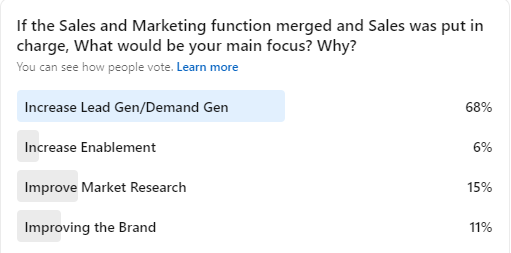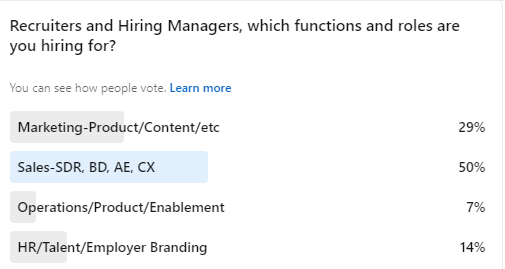How to Create Marketing Sales & Service Teams Need
I asked my LinkedIn audience If the Sales and Marketing function merged and run by Sales, What would be your main focus? Why?

As you can see, 68% of those surveyed said that increase lead generation and demand generation was a top priority. What this means is that people see Marketing as a vehicle to increase Sales and Revenue.
Marketing also serves as an Enablement for Sales Teams, Customer Success, support, and even employer branding. Many companies have created a dedicated enablement function. Companies sit employer branding and Recruitment Marketing in HR. However, there are still a lot of companies without dedicated enablment and employer branding functions.
Everyone looks to the marketing department. The lines between product, marketing, sales, and customer success are blurring.
Marketers do traditional work of branding, advertising, market research, content creation, and enablement, but these tasks support the larger goal of increased Sales and Revenue. Marketers impact Sales and by filing up the Sales pipeline, pre and post-sale. In the end, Marketers need to make a business case to justify their existence.
Sales reps can only be as good as the product and message they represent. Before companies can hire Sales reps, they need a great product with messaging that conveys the benefits to customers. Sales reps need support from marketing in the cross-functional organization of today. The messaging should be able to prevent customer objections. Unfortunately, this is where many Marketing departments fall short.
According to Salesforce.com, “studies show that 82 % of Sellers are out of sync with buyers.”
Many marketing hires lack sales experience; they do not know how to handle and anticipate customer objections. As a result, Sales and Marketing collateral designed to enable front-line teams like Sales are not helpful enough.
Research conducted by CEB Gartner found “80% of Marketing Collateral is trashed and 30% of Sales time is wasted creating the collateral just trashed.”
In addition, many people in Marketing lack the background and understanding of how people learn. Teachers and psychologists have this training. Understanding how people learn can make product messaging more effective because it can be presented in multiple formats. Many people in marketing lack practitioner experience and as a result, marketing is not as effective.
How can Marketing be improved?
Hire Sales Reps, Teachers, and Industry practitioners in marketing roles.
Now I will make a case for hiring Sales Reps, Teachers, and Industry practitioners in marketing.
Case for hiring ex Sales Reps
- Knows how to handle objections which can be applied to message
- Experience dealing with customers knows customer pain points
- Sees how end-user uses the product
- Can increase sales using Sales expertise to make messaging customer-centric
- Can assist with Sales and Marketing Alignment as companies need to work cross-functionally
- Understands the issues Sales Reps face and has the credibility of being a Rep when collaborating with Sales Teams
Experienced obtaining, qualifying, and converting leads to Sales ie Lead gen/demand gen
Hiring Industry practice experts
- They are the customers and understand the pain points better than any market research -should be in leadership roles
Case For hiring Ex Teachers
- understands how people learned
- skilled at tailoring content for understanding based on learning needs
- Today’s marketing is about educating customers and earning the right to market to them as they can educate customers
Why it is not Good enough to only place Industry practice experts and ex Teachers in the Sales Org
People in Sales are not involved in the creative process and cannot change their cards and company messaging.
They cannot address weaknesses in messaging and products.
The Marketer of Tomorrow
1. Understands Marketing as a Service or MAAS
2. Thrives in Data-Driven and Metric Driven Environments
3. Has Writing Ability
4 Has Sales Experience understanding Pain Points of Customer Facing Staff and Customers
My background
I have Marketing experience along with all of the above in my background.
Are you ready to increase Sales by improving Marketing?
Your sales and service teams deserve better!
Change today!
How have you increased Sales by improving messaging?
Comment and share below.
About Me
I’m a Strategic Marketer with Field Sales, Sales Enablement, Content Creation and, Classroom Teacher/Trainer skill-sets using Marketing to drive Sales/Growth.
As a Marketer, I’ve worked with Start-Ups, a Political Campaign, and a Digital Marketing Conference.
I’m certified in Inbound Marketing with classes in Marketing, Product Management, Product Marketing, SEO, SEM.
Before teaching, I was an Outside Sales and Marketing Rep. selling and marketing dental products to Dentists using consultative selling, trade show marketing, field marketing, and market research.
I publish Sales, Marketing & Social Media Today a blog covering industry events and trends.
Articles and insights have been featured, mentioned and, referenced in:
Tractica in the News
The Future of AI
https://medium.com/@DanGalante/the-future-of-ai-insights-from-the-ai-summit-ab6267eca70b
Digital Marketing World Forum
https://www.digitalmarketing-conference.com/key-insights-from-digital-marketing-world-forum-north-america/
Voice Summit
Compilation: Our Favorite Post-VOICE Coverage So Far
https://www.voicesummit.ai/blog/compilation-our-favorite-post-voice-coverage
Engage Bay
7 Steps to Align your Marketing Automation Strategy
https://www.engagebay.com/blog/marketing-automation-strategy/
Relay 42
The Role of Technology in Customer-Centricity
https://relay42.com/resources/blog/the-role-of-technology-in-customer-centricity
Databox
How to Improve Marketing and Sales Alignment (Gave background)
https://databox.com/how-to-improve-sales-marketing-alignment
Onalytica
Named as a Top STEM Influencer for EdTech and Education Industry Insights.
http://www.onalytica.com/blog/posts/stem-top-influencers-brands-publications/
The Arizona Republic
http://yourbusiness.azcentral.com/handle-top-10-sme-sales-objections-24845.html
Twitter Ads Blog
https://blog.twitter.com/2014/how-smartphone-users-engage-on-twitter-three-key-findings
Paper.li’s Wall Of Fame via Scoop.it
http://www.scoop.it/t/all-things-paper-li/?tag=Dan+Galante
I’ve been honored for my Social Profiles
•LinkedIn SSI Score in the Top 1%
•SlideShare for being in the top 5% of profiles viewed in 2014
•LinkedIn Profile was in the top 1% of profiles viewed out of 200 million members in 2012
I’m seeking a full-time role in:
Inbound Marketing, Digital Marketing, Content Marketing, Product Marketing, Demand Generation, Social Media Marketing, Sales Enablement Enablement, Sales Strategy, Marketing Strategy, Employer Branding, Recruitment Marketing.
Open on title, industry, company, location, and level. Reach out on LinkedIn or at dan@dangalante.com to start a conversation.




